Festivals
London Film Festival 2011:
The Sight & Sound blog
Week two »
Correspondences: Jonas Mekas,
José Luis Guerín, Jafar Panahi
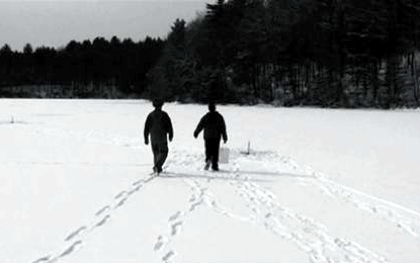
Correspondence
Mar Diestro-Dópido, 21 October
The sheer number of films screened at the larger film festivals effectively means each viewer creates their own personalised festival programme based on a series of not entirely conscious decisions, which can often produce surprise collisions and chance encounters between directors and films. My own choices on day 8 of the LFF, a sunny and crisply cold afternoon at BFI Southbank, put me in the stimulating company of three world-class filmmakers – expat Lithuanian Jonas Mekas, Spaniard José Luis Guerín and Iranian Jafar Panahi – and made me witness to a wholly unexpected but fascinating dialogue between Correspondence: Jonas Mekas - JL Guerín and Panahi’s This Is Not a Film.
‘Correspondences’ is itself a dialogue project originally set up by the CCCB (Centre of Contemporary Art in Barcelona), in which a series of filmmakers are invited to exchange digital visual ‘letters’ about cinema, filmmaking and the world around them. The process was inaugurated by Víctor Erice and Abbas Kiarostami (2006), and includes an exchange between Albert Serra and Lisandro Alonso, The Lord Worked Wonders in Me, also screened at this year’s LFF.
Mekas and Guerín’s Correspondence comprises a total of four digital letters each and an epilogue by the latter, all shot between 2009 and 2011. Guerín, a long-time admirer of Mekas, whose filmmaking philosophy of simply reacting to life and being open to chance Guerín religiously applies to his own films, initiated this particular exchange when visiting Mekas in New York.
Not dissimilarly, Panahi’s This Is Not a Film is a meditation on the powerful need to film, and on being prevented from doing so; we see him in his flat awaiting the outcome of an appeal against accusations of anti-government activities, forbidden to pick up a camera or direct until judgement is passed. As festival director Sandra Hebron pointed out in her introduction, Panahi has since been banned from filmmaking for 20 years, and imprisoned for six.
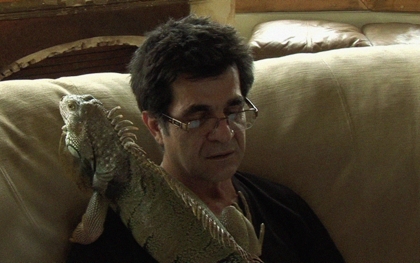
This Is Not a Film
On New Year’s Eve 2010, with symbolically menacing explosions of fireworks as background, Panahi decided, with the help of his collaborator Mojtaba Mirtahmasb, to make this ‘not-film’ in his flat in Tehran, in essence a letter to the future. It consists of Panahi’s narration of one of his banned screenplays, a reflection on his own cinema and a testament of the day he was supposed to find out about the resolution of his trial – because as Mirtashmasb says, what is most important is that we “document everything”.
As Mekas explains, the need to film goes beyond “all that business of reality and poetry. What I’m doing is videotaping moments of life, details I have the need to tape for some reason I don’t know. I have tried to rationalise it, but what I do is what you see, fragments that I tape as life continues. A few moments. Explanations are only part of the game.” It is this inexplicable urge and necessity that makes Panahi risk taking a camera out of his flat to document an encounter in the lift.
Memory, history and ghosts figure in each of these ‘letters’ – moving testaments to cinema’s capture of lost moments, a doomed attempt to arrest life’s ephemerality. By chance I happened to be present at the film festivals in both Lisbon and Ljubljana where Guerín met and filmed Nika Bohinc, the young Slovenian film critic and programmer who was murdered with her Filipino film-critic partner Alexis Tioseco in September 2009 at their house in Manila. Guerín’s third letter is a moving homage to Nika, which not only recalls in its form the painterly study of female faces in his acclaimed In the City of Sylvia (2007), but also gives life to a ghost through editing and repetition, recalling the female presence in the footage he rescues and re-edits in his 1997 film Train of Shadows.
This activity is replicated by Mekas, who we see at his editing table summoning and reflecting on the ghosts of his own past, faded figures in the outtakes of his films that he has decided to collect and edit together in what will be his last testament, which he’ll simply call Footage. The most distressing moment in This Is Not a Film sees Panahi reading his script aloud and attempting to show us a film he cannot make – effectively a ghost film. He carefully divides the rug in his living room with Sellotape to recreate the set and invokes the spirit of his female protagonist (herself imprisoned in her own home), until his escalating desperation culminates in him breaking down.
For all their underlying melancholy, each of these works is united by a playful sense of humour and a liking for animals – pigeons, an iguana, a cat, and a group of stoic ants at Ozu’s gravestone in Japan. Aesthetically they couldn’t be more different, though they’re united by that common Mekas notion of ‘reacting to life’. The restrictions placed on Panahi inevitably impose a domestic naturalism, far removed from Mekas’s distinctive hand-held fragments and Guerín’s crisply beautiful black-and-white images, described by Mekas as “a pure and clear style”. (In the Q&A after Correspondence, Mekas’s first words were: “I take my hat off to Guerín’s mastery.”)
It’s Guerín’s gaze that most clearly structures Correspondence. And yet it is precisely in the contrast between his rigour and Mekas’s highly (to use his own words) “personal and confused”, colourful and chaotic “taping of fragments of life” that meaning – and maybe that hidden order which Guerín is always seeking to capture with his camera – is created and revealed. At the end of the day, filmmakers react as much to each other’s works as they do to life, and the potent (albeit momentary) connections produced by the CCCB series act as a corrective to what Guerín believes is “a time in which filmmakers are more isolated” from one another than ever before.
Most importantly, film allows these three directors to establish a dialogue with the past, history and their own and each other’s present. Tellingly, Mekas captures his own shadow cast on the wall of an 18th-century prison he visits in Poland, while Guerín’s own musings on isolation, rootlessness and displacement – the core of his latest film, Guest – all resonate with Panahi’s situation. But ultimately what unites these three is their need to carry on filming in order to make sense of their world, and the transformative, transgressive force that their films acquire from their ceaseless curiosity, their inspiring faith in the power of cinema. After all, in the words of Mekas, “Reality won’t save us, but dreams will.”
Chicken with Plums: over-plummed?

Sophie Mayer, 20 October
Chicken with Plums (Poulet aux Prunes) is the second outing from the directorial team of Marjane Satrapi and Vincent Paronnaud, and the second in a planned trilogy of adaptations of Satrapi’s elegant black-and-white graphic novels. The first instalment, Persepolis, was one of the highlights of the 2007 London Film Festival, garnering the Sutherland Trophy for best first feature for the pair.
While Persepolis cleverly and precisely translated Satrapi’s instantly recognisable graphic style to the big screen, Chicken with Plums is a more mixed dish: primarily a live-action film, it opens with a 2D animated credit sequence that’s reminiscent of the earlier film, and includes a charming 2D animation in blazing early Disney colours of a story told by Azrael, the Angel of Death, to the film’s protagonist, master violinist Nasser Ali.
Nasser Ali is two days from death by this point, and his hunger-induced hallucinations of past, present and other worlds are intensifying. This sequence, which begins with the startling – and quite funny – appearance of Azrael and moves into the cartoon through a table that turns into a pop-up book, is one of the most assured and involving sections of the film.
The live action, which concerns Nasser Ali’s thwarted love for a beautiful woman named (rather over-symbolically) Irâne, is less involving if always interesting, offering as it does a chaotic but inventive journey through the history of early cinema, with pastiche sequences of slapstick, Expressionism, bold Technicolor and Méliès magic. Fans of early cinema compelled by The Artist will find other references to treasure here – as will fans of screen beauty, treated to Isabella Rossellini, Chiara Mastroianni, Maria de Medeiros and Iranian star Golshifteh Farahani, not to mention a cameo by Sophia Loren’s breasts.
But the talent on screen is let down by the two-dimensional characterisation: a gallery of weak beauties, domineering mothers and shrewish wives. Mathieu Amalric, as Nasser Ali, has more to work with and becomes more effective the closer Nasser Ali is to death, and Jamal Debbouze turns in two welcome if bizarre cameos as a antique dealer and a dervish.
His presence – along with the film’s whimsical, slightly cloying ideas about Art and Love, proclaimed rather baldly by Nasser Ali’s violin guru in Shiraz – call to mind Amélie as much as Persepolis. Lacking a sympathetic central character, and with an uneven tone, it’s unlikely to be as considerable a hit as either.
Toons for all
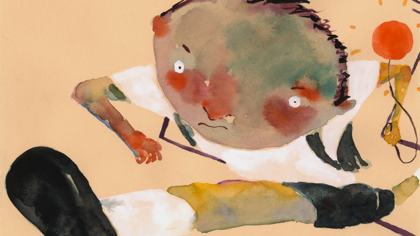
A Gum Boy
Dylan Cave, 18 October
For the past few years the BFI London Film Festival has run ‘Animated Shorts for Younger Audiences’, a programme through which children can discover a variety of animation from Europe and beyond. An exited and exuberant young audience shuffling in their seats, bickering in hushed tones and guzzling contraband sweets quickly settles into the films. This year’s programme offered a wide range of material, from the computer based Trucks and Meatballs (Köttbullarna och Lastbilarna) to vivid the model work of Acorn Boy (Ziluks) and a hectic hand-drawn animation (A Gum Boy, or Kuchao) by talented Japanese newcomer Masaki Okuda.
David Johnson, creator of CBeebies series The Koala Brothers (2003-07), showcased his new film Calamity Island, about two sailors shipwrecked on a remote tropical landscape. Johnson brought along the models that were used in the film and revealed them to a delighted audience who revelled in the contrast between their giant projection onscreen and their actual tiny size.
The teenage voice cast of Pickels in a Pickel – about a careless pig who almost ruins his friends’ day out – also answered keen questions from the floor, only faltering when asked to perform Pickels’ theme song.
An unspoken sense of occasion pervades the whole event, but it’s not all sweeties and delights. Ziluks told an amusing story about a vulnerable acorn being raised by his new forest friends but wasn’t afraid to expose the underling to danger.
And the last film of the programme, I Am Round (Jag Är Rund), broke a beautifully happy dream sequence to offer a blunt, joyless ending. Stunned by this unexpectedly downbeat finale, I looked to my seven-year-old to gauge her mood. She was surprised, and disappointed, but didn’t stop talking about it all the way home.
Nick Bradshaw, 19 October
I took my two-year-old to the family screening of Alain Gagnol and Jean-Loup Felicioli’s animated cat-burglar caper A Cat in Paris, but – felinophile though she may be – she waxed restless half an hour in and showed me the door. I’m still unenlightened as to whether the titular tiger-striped Dino and his nocturnal burglar pal Nico managed to save young Zoe from the dastardly clutches of international treasure-snatching kingpin Victor Costa and his gang of buffoons, or which of them Zoe’s mum – the widowed, work-stressed commissioner of police – decided to pursue. Nor do I know whether the turn-off was the rather sepulchral atmosphere in NFT2 (not to mention the headphone translation), or whether the film’s charms were too energetic for a two-year-old. Maybe all these things.
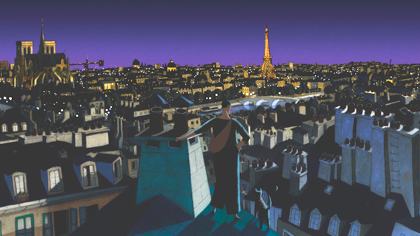
A Cat in Paris
Over in the International Animation Panorama programmes, growing pains and romance were typically the order of the day, though styles at least were diverse. Emma Burch’s Being Bradford Dillman concerned a lonely girl’s brief imaginary friendship with the phantom of the boy that her overly flippant mother claims she was born as; the scenario wasn’t given vastly original treatment, but I liked the (unseen) mother’s alky acidulousness, and the composited hand-coloured foregrounds and photographic backgrounds were handsomely done.
From the National Film & Television School, Corinne Ladeinde’s Ernesto made some sweet music with the vagaries of schoolyard individuality as a young boy’s teeth first fail to fall out like all the other kids’, then start expressing themselves in soul song.
From Portugal, José Miguel Ribeiro’s Dodu the Cardboard Boy was a wordless – and somewhat aimless – reverie about a young dreamer adrift on a sea of his feelings, while (from the Royal College of Art) Yoonah Nam’s Henrick attempted a more layered disquisition about an acquaintance of the narrator, with lots of verbal play and visual metamorphosis; I felt its elliptical philosophy rather ran through my fingers.
Several of the grown-up stories – from Germany, Ralf Kukula’s The Man Who Still Believed in the Stork, a faux-naive urban fairytale about a handsome asexual; from the UK, Neil Boyle’s The Last Belle, a portrait of an abortive blind date with lashings of dramatic irony and virtuoso slapstick; from Argentina, Luminaris, Juan Pablo Zaramella’s expertly pixillated short fantasia about two workers in a light-bulb factory – showed off great style and vim while rehearsing fairly pat storylines.
It’s tempting to level the same criticism at Spike Jonze’s collaboration with Simon Cahn and designer Olympia Le-Tan, To Die By Your Side (Mourir Auprès de Toi), a romance in Paris’s Shakespeare and Co bookshop featuring felt cut-outs characters from the covers of Macbeth, Dracula and Moby Dick; but then again the film never claims the status of anything other than one of Jonze’s quick-fire viral sketches, and the felt animation has the hand-made pleasurableness of a Michel Gondry short. (You can watch it here.)
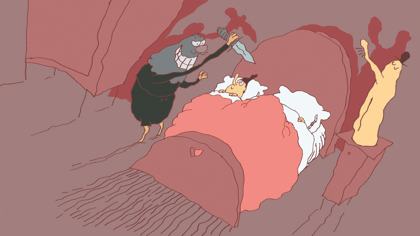
Oedipus
Also daffy fun is Dutch-Canadian master Paul Driessen’s jelly-straight Oedipus, in which the cuckolding milkman of the title takes therapy to rewind his life and try to understand women; besides the gattling-gun pace, Driessen wisely has Oedipus parse his thoughts in loopy Mexican-accented pigeon English.
At the more pensive, ‘refined’ end of the spectrum, Daniel Ojari’s Slow Derek and Koji Yamamura’s Muybridge’s Strings both wordlessly and elliptically reflect on time and change (and feature the old movies-as-trains metaphor). Slow Derek – about an office drudge swept away by the speed of the turning world – feels slighter, but its rich model work is very fetching.
Fluidly pencil-drawn and painted, Muybridge’s Strings re-rehearses the zoopraxographer’s experiments with motion photography and time capture as an analogy for a contemporary mother’s angst about her growing child. It’s beautiful, but if you know your Muybridge it feels a little obvious.
There was also expert biography in veteran animator Barry Purves’s Tchaikovsky: An Elegy – a multimedia synthesis of puppet and model work, animated old photos and quotes from the composer’s diaries and music that teeters between poignant tribute and over-earnest digest (the flat-footed English voice-over doesn’t help its cause).
Dance, dress and negative space meanwhile are the inflecting elements of Fiona Geilinger’s trompe l’oeil minimalist Wallpaper, in which a woman variously reveals and conceals herself against a white backdrop using the shifting shapes of her dress, until she finally embraces the background as wallpaper.
All of which leaves just The Monster of Nix, a tumultuous, bewildering CG musical fantasy epic from Dutch artist / online graphic novelist Rosto featuring an elfin-faced lost urchin, multiple planes of reality, a self-reflexivity (stories are collected inside mercury-coloured ‘eggs’ by stick-like scarecrow figures), a crow with human hands for feet and the voices of both Tom Waits and Terry Gilliam galumphing away on the soundtrack.
A bit of a short-form blockbuster, the film had crowded out all exposition; there was certainly talent flying around the screen – you can see why Gilliam got involved – but no subtlety or respite. I found the handheld CG camerawork of some interest, but otherwise had a yen to show myself the door.
Let’s start giving: early ups and downs
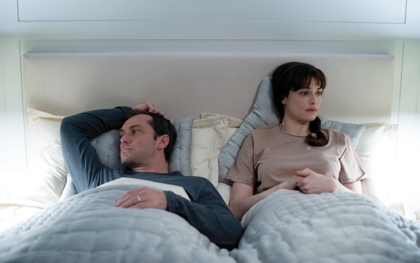
360
Nick James, 18 October
The LFF opening night already seems an age away. For me 360 was a typical example of the ‘We Are the World’ film, in which several minor story strands are intertwined to demonstrate the little-known fact that we’re all human underneath, no matter our country, race or social circumstance. These films – like Alejandro González Iñárittu’s Babel and Lukas Moodysson’s Mammoth – are weak echoes of much greater works on circumstantial collisions of people by Altman and Kieslowski, directors who better understood that the main enemy of such schemes is the certain pleased-with-itself patness that spoils this Fernando Meirelles / Peter Morgan collaboration.
That said, the airport storyline in which Anthony Hopkins, playing a father still looking for a long-lost daughter, intersects with Maria Flor’s cheated-on young Brazilian fleeing London – who in turn tries to come on to Ben Foster’s paroled sex-offender – was very deftly handled, and built towards an extraordinarily tense scene in Flor’s character’s hotel room. One of the film’s financers, who’s heard my complaint against this type of film before, saw me after the screening and sang the opening line to the Michael Jackson / Lionel Richie song at me – a classy provocation.
Friday morning brought the great pleasure of watching a press screening for Nuri Bilge Ceylan’s Once Upon a Time in Anatolia. I’d seen this on the last day of Cannes, when my powers of concentration were suffering, and knew it was great. Second time with a refreshed mind it was even better than I’d thought. It’s an arthouse policier that follows a group of men gathered to find a corpse to which a confessed murderer is trying but failing to guide them. The proceedings involve a long drive through the wind-blasted Anatolian hinterland, and the film’s aesthetic miraculously hints at both Sergio Leone and Samuel Beckett.
It’s a film about faces and hidden motives, and how men in Turkey work together and talk about women. It may be among the most subtly revelatory of films about men ever made, and it resonates like great art should. I heard there was some fractiousness over the lateness of the Q&A session after the festival’s Monday evening screening. What a pity any such feelings should mar discussion of such a wonderful film.
I interviewed Steve McQueen and Michael Fassbender for Shame. You can read my opinion of the film elsewhere; here I just want to flag up that McQueen said some controversial things that we’re holding for when the film is released; and that Fassbender is a very cheery, seemingly ordinary bloke – though few of the young women I’ve told this to seem to believe the “ordinary” part.
I caught up with the first part of the Dreileben trilogy, Beats Being Dead, and admired the way Christian Petzold gets his tentative young lovers into very bright uniforms – hospital orderly and hotel maid – that make them stand out in a dark forest more than any red hood. The film’s oblique plotting succeeded in intriguing me enough to keenly anticipate the next two parts.
When it comes to fascination, though, Yorgos Lanthimos’s Alps takes the whole biscuit barrel. Plausibility is never an issue here because artifice in behaviour is the film’s core subject. ‘The Alps’ are a strange alliance of two hospital workers (one male, one female) and a young woman gymnast and her menacing male coach. Collectively they offer a service to grieving relatives in which they substitute for the dead person to aid the process of grief. Cue many seemingly absurd scenes of re-enactment – the kind of banal domestic conflict that people miss when it’s gone – but the challenge is to claim that such behaviour is any more absurd than other real-life therapies.
The one aspect of Alps not subject to a feeling of absurdity is the threat of violence from the men in the group, which gives every scene a palpable tension. One of the film’s most remarkable features is the utterly convincing performance – in a film that’s trying not to be authentic – of Ariane Labed (the star of Attenberg) as the gymnast. When I met her in the Jameson guest bar after the screening she told me that she trained for two years for the role. I asked if she was still in training. “No, no, never again,” she said. “I hate gymnastics”.
Based on a real-life American case, the French production 17 Girls, written and directed by Delphine and Muriel Coulin, relocates its schoolgirls trying to resist their fate to the run-down port of Lorient. When alpha-female Camille (Louise Grinberg) discovers she’s pregnant, she persuades her closest friends to do the same. Soon the school has to cope with an epidemic of pregnancies. A one-idea film it may be, but it amplifies that idea imaginatively to create a well-observed and well-acted ensemble drama about teenage dreams in a dead-end town.
Equally concerned with young girls and their futures is She Monkeys, an impressionistic portrait of a small-town crush from the Swedish director Lisa Aschan. Two lovely young girls, rivals for a small-town equestrian acrobatics team, become fascinated with each other and develop a curious attachment of mixed emotions and confused urges. This main strand of the film is superbly handled, but I was less sure about a subplot about a seven-year-old sister who insists on exploring her sexuality at that tender age. Then again, it was obviously meant to be unnerving and it succeeded.
Rampart, which reunites most of the team (Oren Moverman, Woody Harrelson and Ben Foster) that made The Messenger a few years back, looked in advance like my kind of movie. It has Harrelson in fearsome form riffing on the kind of troubles that James Ellroy likes to obsess about in his crime novels (Ellroy originated the script), especially in his stunning autobiography My Dark Places. In Rampart, Harrelson plays a cop whose racism makes him a prime candidate to be investigated, thereby taking some of the press heat away from the huge suspicion of police corruption going on in the Rampart division of the LAPD.
Regrettably, as stylishly shot on the new Alexa camera as Rampart was, I believed hardly a single moment. Every character seemed like a set of attitudes, none a believable person. I said this quietly to the Festival Director Sandra Hebron, and she disagreed (as she should), arguing interesting parallels between Rampart and Shame in the two portraits of male self-disintegration.
That’s enough about my LFF, but let me also relate an observation made by my wife Kate Ogborn. Festivals always throw up sub-themes, coincidental connections between movies, and usually they’re of the bizarre variety – a preponderance of pigeons, or a rash of beach drownings. But every one of the five titles Kate has seen (so far, as I write this) captures an event that perhaps ought to be a regular part of cinema but is rarely is: oral sex performed on a woman by a man. 360, Shame, The Loneliest Planet, Rampart and Alps have all shown men prepared to lie down for the cause. I don’t think Kate’s seen The Bitter Taste of Freedom yet, but you never know.
Whose waste?
Mercedes Álvarez’s Futures Market
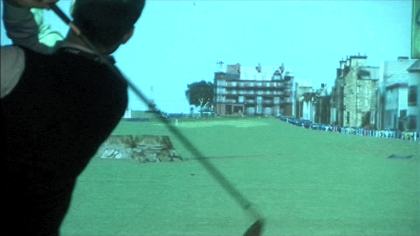
Sophie Mayer, 17 October
It’s a decade since Agnès Varda’s The Gleaners and I brought the mysteries and beauties of waste to the screen, exploring its relation to consumerism and visual art; in the intervening years, documentaries such as Lucy Walker’s Waste Land have focused on the marginal urban spaces of waste disposal, and the marginal, resistant lives that take place there.
Mercedes Álvarez’s 2011 documentary Futures Market follows Varda into the tumbledown flea markets of contemporary Europe. Coupled with its extended focus on Jésus, a junk dealer who refuses to sell his wares, are several strands of observational documentary filmed around the stock market, at corporate motivational conferences and at property fairs, drawing attention to the invisible architects of the postmodern economy at the moment before it crashed, and drawing connections between what is discarded and devalued and the inflation of false values and dreams.
The property fairs are particularly fascinating, not least because their elaborate, life-size promotional photographic backdrops, CGI projections and light-up architectural models implicitly indict mainstream cinema, which similarly uses CGI, backdrops and models as part of the dream factory that sells futures to unwary customers. As Álvarez pointed out in Sunday’s Q&A, these infinitely-replicable models, and the succession of identical corporate spaces in which the fairs and conferences are held, are all we really see of ‘the city’, and render irrelevant the question of which city.
Interrupting these homogenised spaces are three that are more individual: Jésus’ warehouse; a small patch of allotments sandwiched between AVE railtracks and a motorway tunnel, whose vivid green comes as a huge relief to the viewer’s eye; and a baroque apartment which is disassembled at the start of the film.
In contrast to the blankness of postmodern corporate architecture, Álvarez documents the exquisite man-made detail of Renaissance painting and the hand-crafted household objects found in the apartment. While Varda’s film meditates on the ravages of time, Álvarez’s voice-over uses these talismanic objects to excavate the forgotten art of mnemonics, describing Simonides of Ceos’s development of the spatial arrangement of information that allowed him to bear witness to disaster.
The projected, plasticky condos and hotels enticing buyers to Dubai and other dubious locations asks whether the future we imagine is a public space evacuated of memories – or whether Jésus’s chaotic but intimately inventoried warehouse, alive with cats, could offer us fragments to shore against our new ruins.
She’s gotta have it: Pariah
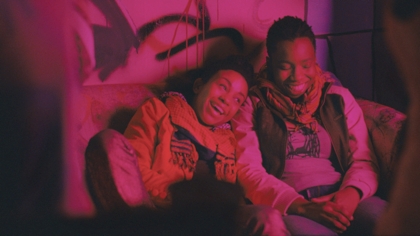
Sophie Mayer, 15 October
With her first feature Pariah, Dee Rees looks set to become one of only a handful of African-American filmmakers to achieve international critical success. Rees’s 2007 short of the same title – her NYU graduate thesis project – won multiple festival awards, and the support of the Sundance Institute and executive producer Spike Lee in helping her develop it into a feature.
Pariah shares its in-your-face cinematography and high-octane performances with Lee’s early work. As in Do the Right Thing, the viewer is thrown headfirst into a vibrant, complex African-American community – here based around the Brooklyn lesbian bar where Alike, the main character, is trying out her moves as an ‘AG’, or aggressive butch. A superbly confident opening, choreographed to Khia’s ‘My Neck, My Back’, lures the viewer into a milieu which has already hooked Alike, even as it threatens to pull apart her home life.
The Oprah-esque family drama of Alike’s coming out to her strict Christian mother and policeman father is only part of what powers the film. It’s most vividly alive – about a hundred times more so than any recent American indie rom-com – when following Alike through her nervy trials of self-definition: sharing her poetry with her English teacher; learning how to be butch from her friend Laura (who has her own family troubles); immersing herself in the Afro-punk scene under the auspices of Bina, daughter of one of her mother’s church friends and a classic femme heartbreaker. But it’s those complex and precise rites of individualism, rather than the romantic or social dramas, that ultimately forms the film’s focus.
As Alike, Adepera Oyude repays Rees’ original decision to cast her back in that 2007 short with a performance that, in its nuances, uncertainties and tremulous energy, calls to mind Claire Danes in My So-Called Life – perhaps meshed with Donald Holden’s George in David Gordon Green’s George Washington. (There’s also a stand-out performance from Brooklyn musician Tamar-kali.) Her story will resonate with anyone who was ever a teenager – whether or not you ever tried wearing a strap-on to impress a girl.
Scraps and gems
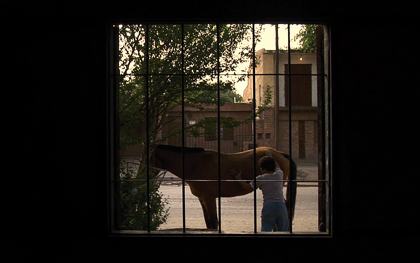
Kieron Corless, 14 October
My strategy with regard to the LFF hasn’t changed in the 20 odd years I’ve been living in London – apart from the stuff I have to see for work and interviews, I focus exclusively on the films which haven’t got a distributor attached (the LFF catalogue helpfully indicates which do and don’t). Chances are if I don’t see these particular films here in London, I’ll never see them again; given the LFF’s position in the calendar, they’re often coming to the end of their festival run.
In that spirit, my first LFF outing last night was an Argentinian film called Yatasto, a debut documentary feature by Hermes Paralluelo, and I have to say straight up it’s a gem. It follows an extended family of refuse recyclers living in Cordoba as they go about their daily round of collection, interleaving more intimate moments shot in their run-down domestic spaces on the outskirts of the city.
It’s by no means a misery fest. Each character, both old and young, registers strongly and vividly, and there’s humour aplenty, often involving the horse and cart the younger members of the family are learning to drive. It will inevitably draw comparisons with Pedro Costa’s Fontainhas trilogy, particularly In Vanda’s Room, thanks to its fixed digital camera, shadowy interiors and subject-matter, but there are key differences – the predominance of children and the trips round the town with the horse and cart give it a lighter tone.
There’s one more screening of Yatasto still to go, and I would highly recommend it if there are any tickets left.
I’ll continue my trawl of the less-publicised films this weekend, starting tomorrow with The Lord Worked Wonders in Me by the brilliant Spanish maverick Albert Serra (Honour of the Knights, Birdsong), which is twinned with a Lisandro Alonso short called Untitled (Letter for Serra). Serra’s film started out as an art commission, but has since screened at several festivals internationally and been lauded as a masterpiece.
I’ll also see a Spanish film called The Waves, about an elderly man revisiting places he fought during the Civil War – it looks promising, at least on paper. The Day He Arrives is the latest Hong Sang-Soo film, not to be missed despite his neglect by British distributors. I’ll also see another much-lauded Argentinian film called Back to Stay, which Isabel Stevens wrote about in her recent Locarno report.
Finally, on Sunday night I can’t wait to see the archive restoration of The Machine That Kills Bad People, described by Finnish filmmaker and archivist Peter von Bagh as “the strangest of all Rosselini films”. Together with that brilliant title, there can be no stronger recommendation.
Day one: Starter’s orders
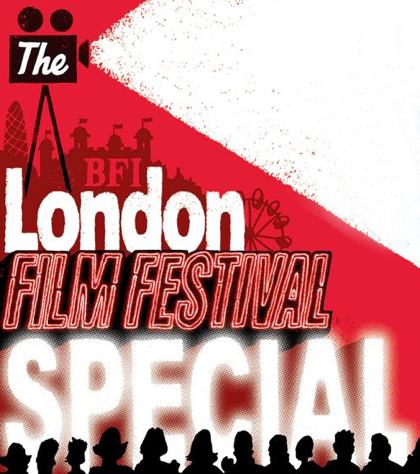
Nick James, 12 October
Welcome to the Sight & Sound BFI London Film Festival rolling blog, except that the festival hasn’t started yet. We’re under starter’s orders but we’re not yet off (a matter of opinion, I know). Tonight the glitz begins with black tie and free chocolate at the opening gala. I don’t know which stars amongst the radiant cast of Fernando Meirelles’s film 360 will be turning up, but I know the proceedings by heart.
While we wait for the film in our penguin suits, interviews conducted outside the Odeon Leicester Square are usually projected onto the enormous screen inside, but with Leicester Square currently a building site that might be harder to achieve. We will, I hope, see the vintage organ pop up for a few tunes and patiently wait while the paparazzi fire off their thousand flashes. But wait a minute, this is a Sight & Sound blog – why am I channelling Ryan Seacrest?
Partly it’s in reaction to a letter we received today from a German reader who feels that we bang on about Britain far too much for a magazine that boasts the strapline ‘The International Film Magazine’. She may have a point. But, as someone who travels the world to many film festivals, the BFI LFF does seem to have a few advantages, and not just the obvious one I’ve banged on about for years – that it’s a Greatest Hits of the year event because it doesn’t have an official competition prize.
It’s also neatly poised at the moment before the pre-Christmas film crush that leads in turn to the awards season and so it is very useful to the distributors who own the rights to show these films, so it gets more of them. It’s true that Toronto, for instance, can match nearly all of these boasts, and that it is still quite possible, though increasingly difficult, to encounter unnecessary films at the LFF. I just no longer know in advance which they are. The LFF programme really is chock-full of the world’s cinema at its most stimulating – and, pace our German reader, it’s the best opportunity for most of our readers to see most of these films.
I’ve already seen getting on for 40 of the films in the programme and yet there are another 40 I want to see. Some of them are big films – I haven’t seen tonight’s opener, for instance, Clooney’s The Ides of March, or Winterbottom’s Trishna – but most are the kind of films you can only see at festivals. Even for someone as privileged in access as myself, this may represent the one time I can catch that little known but terrific film that might otherwise vanish without trace.
The S&S blog is going to be a freewheeling mix of different levels of comment and observation from a number of contributors, some familiar to you – like the editorial team members Kieron Corless, Isabel Stevens, James Bell and Nick Bradshaw – others not so much. It’s best to think of it as informal S&S, on its swift coffee break between films and out to pick up on the interesting trends and comments doing the rounds. Never mind Bette Davis, I’m hoping for a smooth ride.
